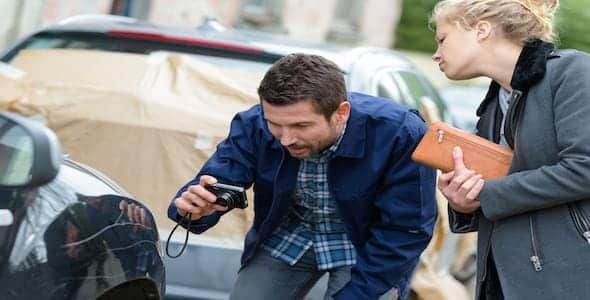Michigan roads see their fair share of accidents. More than 244,000 total accidents of which 44,417 people suffered injuries and another 1,010 lost their lives in crashes according to the most recent annual crash statistics compiled by the State of Michigan. More than 19,000 of the accidents took place in the tri-county area. That’s why you should be aware of these seven tips for taking accident photos of your injuries and of the crash scene.
Strengthen Your Injury Claim by Recalling Accident Details Despite Stress
If you suffer injuries in an accident caused by the negligence of another driver, you should consider pursuing a personal injury claim. In the event that you do, you will need to recall details about what the accident scene looked like when meeting with a personal injury lawyer. Sometimes the shock of a crash can cause your adrenaline to flow, which can lead to confusion and anxiety after a car crash that may make it difficult to accurately recall the details of the accident.
The age old cliché, a picture speaks a thousand words, is right on point when it comes to photos being compelling evidence in a motorist negligence case. Taking photos of your injuries and accident scene are priceless in proving an at-fault driver caused your injuries. Here are some tips to remember when taking evidence photos.
Take photos at different angles of the scene
You generally don’t get a second chance at taking photos of your injuries and the accident scene so documenting the scene of the accident and injuries thoroughly using photos is important. All too often we hear, I should have taken one at this angle or that angle. Always take the opportunity to document the accident scene through plenty of photos at different angles. You can always delete the pictures you don’t need. You won’t get a second chance if you discover later that you missed an important shot of the accident.
Take photos of all your injuries and the whole accident scene
Photographs of your injuries such as bruises, scraps, wounds, deformities, and the entire accident scene from every angle you can possibly think of. If possible, take close ups and then step back to get the entire scene in one photo and move around to get similar photos from different angles and distances.
Keep the many angles approach in mind when taking pictures of the exterior of the vehicles involved in the crash. You want photos of entirety of all vehicles involved and not only the portion showing where the damage is located.
Photos can help you recall and recreate a sudden, violent event, so try to document the entire scene including:
- Skid marks, yaw marks, gouges, shattered glass, debris, fluid, and parts of vehicles that may be on the ground.
- Traffic lights, lane lines, and street signs.
- License plates and vehicle identification number of each vehicle involved in the crash.
- Weather conditions, including clouds, fog, ice, sleet, snow, and rain.
Photos of buildings nearby the accident scene may help your attorney locate witnesses or security-camera video of the accident.
Photographs of the interior of the vehicles involved
You should take several photos from varying angles and distances of the interior of all the vehicles. A picture showing whether an airbag deployed, broken seat, or broken glass can be crucial evidence that may support a claim against the manufacturer of the vehicle or the company responsible for making the airbag if the airbag failed to deploy.
Do not ignore blood stains on interior surfaces of a vehicle. It may turn out to be blood stains can help your attorney or an accident investigator to recreate the cause of the injuries suffered by you or other occupants of your vehicle in the crash.
Look at the quality of the photos as you take them
As you take photograph the accident scene, stop occasionally to look at the picture quality. You may not be focused properly or not enough sum light. In most cases, all you need is sun light to get excellent outdoor photos. However, at night time make sure you flash is on. Other times you may need to activate the flash on your camera for shots of the interior of a vehicle or a skid mark on the pavement in an area that is shaded by a building or tree. The only way to know if you have taken good pictures is to occasionally look at the photos you are taking.
Take photos of your injuries over time
A bruise or cut on your head that is visible at the scene may go away or fade within hours. But it could be valuable evidence in documenting an injury, such as a concussion, scar, or evidence of what caused your injuries in the crash. If you are unable to take the photographs yourself, ask a friend or family member to take the photos for you.
Document the presence of witnesses and other people at the scene of the car crash
All too often, car accident victims are shy about taking pictures of people at the accident scene. The following information about people at the accident scene include:
- Drivers and occupants of all vehicles.
- Witnesses and bystanders.
- Police, fire and rescue, and emergency medical personnel.
- Police, fire, and ambulance vehicles,
Photos of police cars and other emergency vehicles should include identifying numbers and department names.
Photograph insurance certificates and driver’s license information about the other drivers instead of writing it down because it’s easier and more accurate. You can do the same thing for witnesses by asking for permission to photograph a driver’s license or other state identification. Photos of documents rather than writing info down to avoid incorrect spellings or transposed numbers in addresses that could make it difficult to contact the person.
Preserve photographic evidence
Many times, we are asked should I throw away the photos of my accident? Don’t throw away photographs you have taken of your injuries or accident scene because you may not know the value of the photos. Always speak to an experienced car accident injury attorney before you discard or delete photos. Don’t delete photos until you have met with one of our seasoned personal injury lawyers to evaluate your photos. You may not know the value of a picture in your case until the eyes of a lawyer has examined all of the photos before you think they are unnecessary.
Talk to a Michigan Personal Injury Attorney
Getting advice from an experienced Michigan personal injury attorney is equally as important to the success of a claim. It is a good idea to schedule a consultation as soon as possible to let your attorney get started. Call 866-HIRE-JOE to speak to an experienced lawyer at The Joseph Dedvukaj Firm or fill out this contact form to get a free case evaluation.


